Tetracycline is an established antibiotic and is targets to Wolbachia endosymbiont present within the filarial worms. Antibiotic treatment of filarial nematodes results in sterility and inhibits larval development and adult worm viability; this is due to effect on the Wolbachia. In the present study in vitro and in vivo anti-filarial effect of different concentration of tetracycline/ doxycycline was determined. In vitro results indicated that 50 µg/ml and 100 µg/ml tetracycline concentrations affects the motility in both microfilariae and adult worms of B. malayi. The loss of motility was efficiently higher in female adult worms than male adult worms, could be attributed to the differences in Wolbachia load of the filarial worms. 14 (10 Male and 4 female) microfilaraemic subjects were treated with doxycycline @ 200mg/day for 30 days to study the in vivo filaricidal effect. In which the mean mf counts were gradually decreased after doxycycline treatment in both male and female subjects upto 6 months. The findings suggest that tetracycline/ doxycycline treatment can eliminate or reduce the mf load due to targeting Wolbachia endosymbiont therefore provide good tool for treatment and to hamper the transmission of filariasis from one host to another.
Wolbachia, Tetracycline, Doxycycline, in vitro, Filariasis, Brugia malayi.
© The Author(s) 2017. Open Access. This article is distributed under the terms of the Creative Commons Attribution 4.0 International License which permits unrestricted use, sharing, distribution, and reproduction in any medium, provided you give appropriate credit to the original author(s) and the source, provide a link to the Creative Commons license, and indicate if changes were made.


